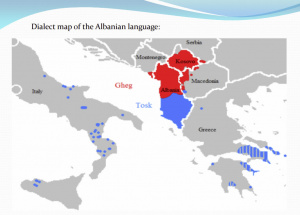Language/Tosk-albanian/Grammar/Verbs-and-Present-Tense
As a beginner in Tosk Albanian, understanding how to use verbs in the present tense is crucial. In this lesson, we will cover the fundamental principles of Tosk Albanian verbs and their conjugation in the present tense.
Introduction
Verbs are essential in Tosk Albanian as they carry most of the meaning in a sentence. The present tense tells us that an action is occurring right now, has been happening for a while or will continue to happen later. Once you have mastered the present tense, using verbs in the past and future tense will come naturally.
Tosk Albanian Conjugation
Tosk Albanian verbs have two aspects: the stem and the ending. The stem refers to the base form of the verb (e.g., shkruaj- write) without any inflection. The principle of verb conjugation requires adding the proper ending to the stem according to the person, number and mood. Let's conjugate the verb shkruaj- write in the present tense for all persons:
| Person | Tosk Albanian | Pronunciation | English |
|---|---|---|---|
| Unë shkruaj | Uneh shkroo - eye | I write | |
| Ti shkruan | Tee shkroo - ahn | You write (informal) | |
| Ai/ajo shkruan | Ah-ee/ah-yoh shkroo - ahn | He/she writes | |
| Ne shkruajmë | Neh shkroo - ahm | We write | |
| Ju shkruani | Yoo shkroo - ah-nee | You write (formal) | |
| Ata/ato shkruajnë | Ah-tahs/ah-tohs shkroo - ah-nyeh | They write |
As you can see, the verb stem shkruaj- remains constant throughout its conjugation in the present tense. The ending varies depending on the person, which took the place of the empty subject. In Tosk Albanian, the subject is frequently omitted in the sentence, as it can be deduced from the verb ending.
It's essential to pay attention to the vowel harmony, which occurs when a verb ends in a consonant. In this case, the subject pronoun gets an additional vowel 'ë' between the verb stem and the verb ending. The vowel 'ë' helps to pronounce the verb's two consecutive consonants more easily.
Regular and Irregular Verbs
Most Tosk Albanian verbs follow regular conjugation patterns in the present tense, where the only thing that changes is the ending. However, some verbs don't follow these standard rules, and they are called irregular verbs. Irregular verbs might have a different stem or a unique form of ending conjugation, and learners need to memorize them. Here are some examples of irregular verbs in the present tense:
- Jam - to be:
| Person | Tosk Albanian | Pronunciation | English |
|---|---|---|---|
| Unë jam | Uneh yam | I am | |
| Ti je | Tee yeh | You are (informal) | |
| Ai/ajo është | Ah-ee/ah-yoh est | He/she is | |
| Ne jemi | Neh yeh-mee | We are | |
| Ju jeni | Yoo yeh-nee | You are (formal) | |
| Ata/ato janë | Ah-tahs/ah-tohs yah-nyeh | They are |
- Dua - to want:
| Person | Tosk Albanian | Pronunciation | English |
|---|---|---|---|
| Unë dua | Uneh doowah | I want | |
| Ti do | Tee doh | You want (informal) | |
| Ai/ajo dëshiron | Ah-ee/ah-yoh deshi-rohn | He/she wants | |
| Ne duam | Neh dooahm | We want | |
| Ju doni | Yoo doh-nee | You want (formal) | |
| Ata/ato duan | Ah-tahs/ah-tohs dooahn | They want |
Tips for Learning Tosk Albanian Conjugations
Some verbs follow different conjugations in different regions and dialects across Albania. However, the present tense verb conjugation is relatively standardized across the Tosk Albanian-speaking areas, with some exceptions.
- Learn the verbs' stems and conjugation patterns by heart. - Watch and listen to Albanian songs, series, or movies to familiarize yourself with the sounds of the language and the right accent use. - Try to make and memorize simple phrases with the verbs you are learning. - Don't forget to practice regularly with native speakers or your Albanian teacher to improve your pronunciation and application.
Conclusion
Using verbs in the present tense essential to build a solid foundation in any language, including Tosk Albanian. Regular and irregular verbs in the present tense follow standard pattern conjugations, while you should memorize irregular verbs' endings and stems. Keep practicing and expand your vocabulary to master the present tense in Tosk Albanian gradually.

